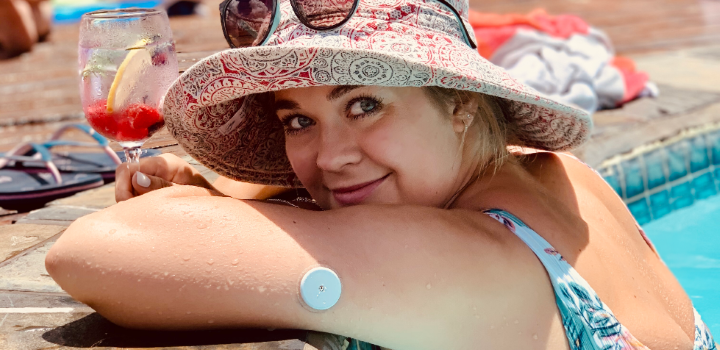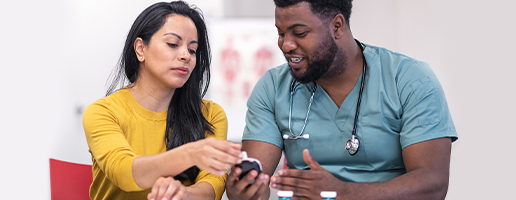Life-changing sensor for people who have type 1 diabetes

Emma Allen was diagnosed with type 1 diabetes when she was 11 years old. For 14 years, she's pricked her fingers five times a day to check her blood sugar levels. Now, medical scheme funding for a game-changing sensor that attaches to her skin and links to a mobile app has changed her life.
On 9 February 2021, Emma celebrated the 14th anniversary of the day she was diagnosed with type 1 diabetes. She posted an image on her Instagram profile to show the continuous glucose monitor sensor on her arm. She celebrates the day because she has chosen to see all of the good that the diagnosis has brought to her life - from her supportive loved ones to her insight into health and wellness, and opportunities to raise awareness about the condition wherever she can.
"This device is such a game-changer and a life-saver"
"The most common way that people who have diabetes check their blood sugar is with a finger prick. It allows for blood to be put on a test strip, which is inserted into a little glucose monitor machine," explains Emma. "However, this method means repeated finger pricks all day and night, and you only gain insight into your blood sugar at that specific moment in time. You have no sense of how controlled your blood sugar has been and whether it's increasing or decreasing. It's very easy to miscalculate how much insulin one needs to inject to balance the blood sugar. People with type 1 diabetes therefore often experience blood sugar that is too high (having injected too little insulin) or too low (having injected too much insulin). This can be frustrating and potentially dangerous - even lethal. It's also tough having to prick your finger up to five times a day. Added to this is the fact that most of those who are diagnosed with type 1 diabetes are children. Constant finger pricks are really a challenge to normalise as part of a child's life."
"This is why a continuous glucose monitoring sensor is such a game-changer and a life-saver. It gives me the most accurate vision of what my blood sugar is doing at every point of the day. Being so aware of what my body is doing and how it reacts to certain things (stress, food, exercise, fluids) is so important for my general health, and to prevent future life-threatening complications."
All Emma needs to do to check her blood sugar levels at any point is scan the sensor device app on her smartphone over the actual sensor for a reading. Emma wears the patch for two weeks before it needs replacing. She can exercise outdoors or at the gym, shower, bath, swim and do anything else she wants to do while wearing it.
"I can check my blood sugar 40 times a day, with no needles in my fingers"
The sensor tracks Emma's blood sugar levels throughout the day, even while Emma is asleep, with a new reading available every five minutes. Emma can scan for a real-time blood sugar reading as many times as she likes, day or night. It's easy to attach (a fine needle inserts into the arm to measure blood glucose) and comfortable to wear. The device saves Emma's blood glucose readings for eight hours at a time. So she has a constant picture of her blood glucose levels and how they are rising or falling. This insight tells her how well she is managing them through her insulin injections, food and fluid intake, and other lifestyle habits.
"I have also given my doctor permission to access the sensor device app. They can check my blood sugar readings at any time. I can call if I don't feel well or experience a blood sugar high or low. They can then remotely access my real-time readings and guide me as to what to do. It's incredible to have this sort of technology at our fingertips."
Discovery Health Medical Scheme funding helps Emma to pay for her sensors
Emma explains, "After 14 years, nearly 30 000 finger pricks, and only being aware of what my blood sugar levels were at about five points in the day, I am now able to test myself 40 times a day, with no needles in my fingers, and no blood draws needed. More control, less stress, less limits, and much more happiness. I don't think I can put into words just how much of an impact this device has had on my life.
"It fills me with so much joy that in 2021, Discovery Health Medical Scheme (DHMS) has agreed to fund the bulk of the cost of Continuous Glucose Monitoring (CGM) devices for people who have type 1 diabetes. Where I paid R2000 a month in the past for two sensors on my Classic Priority plan, I now pay R390 a month towards each sensor, so R780 in total." Emma's insulin medicine is covered in full.
What is type 1 diabetes?
Type 1 diabetes is an autoimmune disorder. This means that it occurs when the body's own immune system damages the pancreas - the organ that produces a hormone called insulin. It's often not clear why this happens, or what triggers the damage.
Type 1 diabetes is more commonly diagnosed in children than in adults. Adults who are diagnosed with diabetes most often have type 2 diabetes, which can be prevented or delayed through healthy lifestyle habits.
- Why do we need insulin? When we eat carbohydrates, our food is broken down in the digestive system into glucose (sugar molecules). The glucose goes into the blood stream so that it can move around the body to cells where it is stored or used as energy.
- However, when the pancreas can't produce enough insulin (as in type 1 diabetes), glucose can't enter the cells and it builds up in the blood. High blood sugar is very dangerous. It can cause problems with blood vessels, nerves, eyes, kidneys, the heart and other areas of the body.
- This means that people who have diabetes - whether type 1 or 2 - must regularly monitor and balance the amount of sugar in their blood. They can do this by pricking their fingers and putting blood drops on to a test strip, which is inserted into a blood glucose monitor for a reading. They can also use Continuous Glucose Monitoring devices like Emma's.
Emma recalls when she was diagnosed with type 1 diabetes
"I had some of the major symptoms of type 1 diabetes," says Emma. "However, we hadn't realised what was going on. I lost 8 kg in a month, I was very thirsty and urinating frequently, and I was completely exhausted. On the day of my diagnosis, my mom took me to the GP and my blood sugar reading was dangerously high at 29 mmol/L. It should have been between 5 mmol/L and 7 mmol/L. Thankfully we caught my condition early and I was put on injected insulin medicine right away."
"I remember my mom coming to school to meet with me at break"
"It all took a huge adjustment. I was about to go into high school, so we had a good routine. My doctor also came to the school and spoke to all my teachers and everyone really looked after me."
"We had grown up living and eating very healthily thanks to my mom, so we didn't have to make many dietary changes. My mom really took on the process of understanding the condition and handling my insulin injections. I soon learned to prick my own finger, put the blood on to a test strip and put that into my little portable blood glucose machine. I would then inject myself with insulin. However, learning how much insulin to inject is the challenge. I remember my mom coming to school to meet with me at break. We would test before I ate food, inject the right amount of insulin, I would eat, and we would test my blood sugar again 15 minutes later. I also tested myself later in the day and sent her a message with my readings."
"My mom had to come along on my Grade 6 and 7 school camps, which was mortifying! That made me feel so different. What really helped me was going away on camps run by Youth with Diabetes. They teach coping mechanisms and helped us to cope with the mental and emotional elements of the diagnosis. When I turned 16, I became a mentor and facilitator for children on the camps."
"After high school, I studied at Stellenbosch and my diabetes was my responsibility alone. I was proud that I was able to do anything and everything that students do. This was a turning point in my confidence in managing the condition long term. Over time, I have also gained really compassionate and informed friends, and I feel so supported." Today, Emma works as a freelance graphic designer from her Joburg home office.
People who live with type 1 diabetes are always planning ahead
I have always eaten very healthily. However, in line with quickly correcting low blood sugar, I have sugary drinks or sweets on hand. For example, I keep sweets of some sort with me for the times I am not home and my blood sugar gets too low. I also always have a sugary drink and sweets with me in the car. I always make sure my blood sugar is stable before I drive. People who have type 1 diabetes also always need to make sure we have our insulin with us. If I want to go hiking, which I love to do, I take carbohydrate foods and drinks. This is so that I am never stuck on a mountain with a bad blood sugar low. Before I have drinks with friends, I have to make sure my blood sugars are stable. I monitor myself constantly while out. When I exercise, if I go for a run or do cardiovascular exercise, my sugars will spike and drop later. However, weightlifting stabilises my sugars all day. With every decision or activity comes the need to think about how much insulin I have injected and when and what I have eaten. It becomes second nature, but it can be challenging.
"Forget about being shy about it and live your fullest life"
"I really can - and do - eat what I like, knowing that some choices are clearly better for keeping blood sugars more controlled than others. The beauty is that I am in control of how much insulin I inject. With the sensor, I now have seamless insight into my blood sugar levels, which has added infinitely to my sense of freedom."
"I am no longer worried about how other people will react to my condition. I know that it can feel really feel unfair and uncool for teenagers who are diagnosed with type 1 diabetes. The trick is to own the diagnosis. Take charge and know that you may be sick on some level, but you have a condition you can live a long and happy life with, if it is well controlled. Forget about being shy about it and live your fullest life."
- Find out more about Discovery Health Medical Scheme's new cover for continuous glucose monitoring for type 1 diabetes
- Find out more your continuous glucose monitoring cover.
Watch how Emma uses her life-saving device
Here for you, here for your health
Feel reassured that you're not alone if you are living with diabetes. The Diabetes Care Programme gives you access to enhanced support and additional benefits to best manage your condition.
To learn more about the Diabetes Care Programme watch this video.
Related articles

How Hilton Coltman got the wind back in his sails through the Diabetes Care Programme
A 57-year-old diagnosed with diabetes from Port Elizabeth recalls having no gusto before the Diabetes Care Programme came to his aid.

Diabetes Care gives you extra help for diabetes
If you have diabetes, you have to keep measuring your blood sugar and taking your medicine. The Chronic Illness Benefit helps with the basics, but Diabetes Care gives you and your Premier Plus GP access to more tools and benefits to give you the best support and health outcomes.

Diabetes-fighting medical team puts patients at the centre of care
There's a lot the world can learn from a medical team working in small-town KwaZulu-Natal, and treating diabetes through innovation and collaboration.